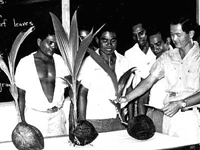Apollo 11 Water Recovery System
National Air and Space Museum curator Allan Needell describes the sea landing and recovery process for the Apollo 11 command module, from the first manned landing on the moon. He looks at the boilerplate command module now displayed in the Steve F. Udvar-Hazy Center, once used by the Apollo 11 team to practice module egress, and the flotation spheres and collar displayed with the boilerplate.
